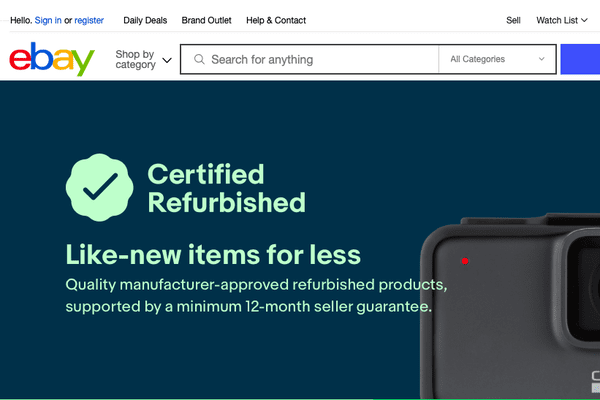eBay launched its Certified Refurbished project earlier this year both in order to meet growing customer demand for refurbished goods and to enable brands to ensure their products meet their own quality control standards on marketplaces.
Matt Potter, who heads the eBay scheme, says its aim is to showcase the premium end of the refurbished range. “It gives brands a better way of way of protecting their brands on the platform,” he says. “They can be confident the product being sold is to their standards, with a Certified Refurbished stamp of approval.”
The launch came in response to rising levels of demand for products from refurbished printers (+301% between January and February 20 2021 compared to the same time last year) and TVs (+103%) to laptops (+75%) and coffee machines (+35%). In order to respond to this growing appetite from millions of customers, it invited brands to take part in a new hub dedicated to selling previously sold products that are refurbished to ‘like new’ standards.
More than 70 brands – from Dyson and Philips to Eve and GoPro – now sell domestic appliances, electronics, garden power tools and homewares via the Certified Refurbished hub. Each product is inspected, cleaned and refurbished either directly by the manufacturer or by a trusted vendor. Goods sold through the hub benefit from a 12 month guarantee that all sellers have to provide – and are an average of 30% cheaper.
The scheme is just one example of how eBay works with the brands whose goods are sold on the marketplace – and more brands are now opting to work with the marketplace to sell goods, whether refurbished, returned or new. Potter says: “We’re seeing over the past year, with the pandemic, a really big increase in the number of brands and retailers wanting to look into a marketplace strategy. We’d encourage that and will work with brands to do that.” Brands can opt to have their own eBay store. Alternatively they can authorise a third-party retailer to operate their brand store on their behalf – and some authorised sellers work closely with both the brand and with eBay. Unlike some other marketplaces, eBay does not handle fulfilment for retailers. But while it cannot share data in-depth it can talk about what the eBay customer is looking for,
Getting to know marketplaces
Potter sees a growing interest from brands in selling via marketplaces and in developing marketplace strategies. “What I know about the brands and why they are coming more onto marketplaces – and in particular eBay – is the customer base, the traffic since we have the customers there already.
“It feels like a brand would have their bricks and mortar strategy and ecommerce strategy, and part of their ecommerce strategy would be their marketplace strategy because that’s where customers are and looking for these kinds of products. It makes sense for brands to be working with marketplaces.”
At heart, he says, an eBay strategy is very like brands’ strategy for selling direct online.
“Demand in the market should be reflected on eBay because eBay’s got so many customers,” says Potter. “If the demand is there in the market, the demand is there on eBay. So make sure you’re on, make sure you’re competitive, make sure the listings are the best quality they can possibly be, and take advantage of the tools – including marketing and advertising – that are there to make the most of the presence on the marketplace.”
This piece first appeared in the RetailX Brands and Marketplaces report 2021. Click here to download and explore the report further.










